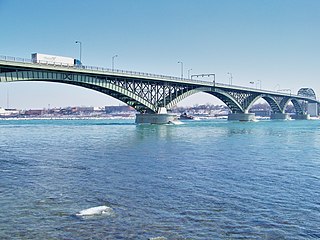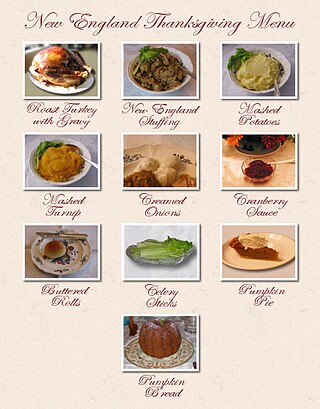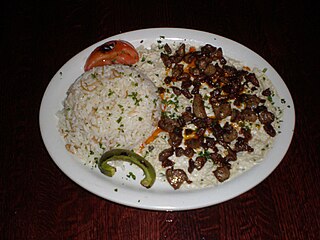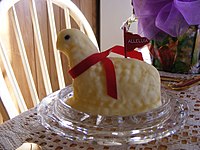
Buffalo is a city in the U.S. state of New York and the county seat of Erie County. It lies in Western New York at the eastern end of Lake Erie, at the head of the Niagara River on the Canada–United States border. With a population of 278,349 according to the 2020 census, Buffalo is the second-most populous city in New York state after New York City, and the 81st-most populous city in the U.S. Buffalo and the city of Niagara Falls together make up the two-county Buffalo–Niagara Falls metropolitan area, which had an estimated population of 1.2 million in 2020, making it the 49th-largest metro area in the U.S.

Turkish cuisine is the cuisine of Turkey and the Turkish diaspora. Although the cuisine took its current rich form after numerous cultural interactions throughout centuries, it should not be confused with other cuisines such as Ottoman cuisine or Seljuk cuisine. Turkish cuisine with traditional Turkic elements such as yogurt, ayran, kaymak, exerts and gains influences to and from Mediterranean, Balkan, Middle Eastern, Central Asian and Eastern European cuisines.

Kebab, kabob, kebap, kebob, or kabab (Kashmir) is a variety of roasted meat dishes that originated in the Middle East.

Pierogi are filled dumplings made by wrapping unleavened dough around a filling and cooked in boiling water. They are occasionally flavored with a savory or sweet garnish. Typical fillings include potato, cheese, quark, sauerkraut, ground meat, mushrooms, fruits, and/or berries. Savory pierogi are often served with a topping of sour cream, fried onions, or both.

Russian cuisine is a collection of the different dishes and cooking traditions of the Russian people as well as a list of culinary products popular in Russia, with most names being known since pre-Soviet times, coming from all kinds of social circles.

Dolma is a family of stuffed dishes associated with Ottoman cuisine, typically made with a filling of rice, minced meat, offal, seafood, fruit, or any combination of these inside a vegetable or a leaf wrapping. Wrapped dolma, specifically, are known as sarma, made by rolling grape, cabbage, or other leaves around the filling. Dolma can be served warm or at room temperature and are common in modern cuisines of regions and nations that once were part of the Ottoman Empire it is also popular in Iran.

Manti is a type of dumpling mainly found in Turkish cuisine, Armenian cuisine and Central Asian cuisine but also in West Asia, South Caucasus, and the Balkans. Manti is also popular among Chinese Muslims, and it is consumed throughout post-Soviet countries, where the dish spread from the Central Asian republics. The dumplings typically consist of a spiced meat mixture, usually lamb or ground beef, wrapped in a thin dough sheet which is then boiled or steamed. The size and shape of manti vary significantly depending on geographic location.

The centerpiece of contemporary Thanksgiving in the United States is Thanksgiving dinner, a large meal generally centered on a large roasted turkey. Thanksgiving could be considered the largest eating event in the United States as measured by retail sales of food and beverages and by estimates of individual food intake. People often consume as much as three or four thousand calories during the course of the dinner.

The National Thanksgiving Turkey Presentation is a ceremony that takes place at the White House every year shortly before Thanksgiving. The president of the United States is presented with a live domestic turkey by the National Turkey Federation (NTF), usually males of the Broad Breasted White variety. The early years also included a joint presentation with the Poultry and Egg National Board. The ceremony dates back to the 1940s; these turkeys were usually slaughtered and eaten prior to the 1970s, when it became standard practice to spare the turkey. During the presidency of George H. W. Bush, it became a tradition for the president to issue a ceremonial "pardon" to the turkey. It is a tradition that the turkeys be picked from the chairperson of the NTF's home state, occasionally from the chair's own farm.

In many European countries, particularly in Central and Eastern Europe, there are various traditions surrounding the use of bread during the Easter holidays. Traditionally the practice of eating Easter bread or sweetened "communion" bread traces its origin back to Byzantium, Eastern Catholicism and the Orthodox Christian church. The recipe for sweetened or "honey-leavened" bread may date back as far as the Homeric Greek period based on anecdotal evidence from classical texts.

Tsoureki also known as šurēk, čöreg, čʿorek, katʿnahuncʿ, çörək (Azerbaijani), çyrek (Albanian), kozunak, cozonac (Romanian) or paskalya çöreği (Turkish) is a sweet holiday bread made with flour, milk, butter, eggs, and sugar and commonly seasoned with orange zest, mastic resin, or mahlab. Lampropsomo, a variation of tsoureki commonly called "Greek Easter bread," is made by Greek communities during Easter, not only in Greece, but also in other countries with Greek communities. It is also called Armenian Easter bread and gets eaten during Easter in Armenia and the Armenian diaspora.

Eastern Hills Mall is a shopping mall located 11 miles northeast of Buffalo, New York on the western border of the Town of Clarence in Erie County, New York, United States. It lies on Transit Road. The mall is north of the junction of NY-78 with NY-5, and Main Street. The name "Eastern Hills" refers to the very low hills that contribute to a slightly higher elevation than the bordering areas along the Onondaga Escarpment. Eastern Hills Mall is part of a long commercial strip on Transit Road. Currently the mall is anchored by JCPenney, Raymour & Flanigan, Orvis, and Niagara Emporium.

Canalside, formerly known as Canal Side and also referred to as Erie Canal Harbor, is a commercial and residential district in downtown Buffalo, New York. It is the recreation of the western terminus of the Erie Canal, which was destroyed in the early 20th century. Canalside is situated on the Buffalo River, in an area that was historically home to the Seneca people.

Easter traditions are customs and practices that are followed in various cultures and communities around the world to celebrate Easter, which is the central feast in Christianity, commemorating the resurrection of Jesus. The Easter season is seen as a time of celebration and feasting, in contrast to the antecedent season of Lent, which is a time of penitence and fasting.

Alinazik kebab, or simply Ali Nazik, is a home-style Turkish dish which is a specialty of the Gaziantep province of Turkey. It is made from smoked and spiced eggplant, grilled and then pureed, topped with cubes of sauteed lamb, previously seasoned and marinated. It is usually served with rice pilaf or yogurt with garlic, grilled vegetables, and melted butter.

Qurabiya also ghraybe, ghorayeba, ghoriba, ghribia, ghraïba, gurabija, ghriyyaba, or kourabiedes and numerous other spellings and pronunciations, is a shortbread-type biscuit, usually made with ground almonds. Versions are found in most Arab, Balkan and Ottoman cuisines, with various different forms and recipes. They are similar to polvorones from Andalusia.

The holiday of Easter is associated with various Easter customs and foodways. Preparing, coloring, and decorating Easter eggs is one such popular tradition. Lamb is eaten in many countries, mirroring the Jewish Passover meal.

Kielbasa is any type of meat sausage from Poland and a staple of Polish cuisine. It is also known in other world cuisines; in American English, the word typically refers to a coarse, U-shaped smoked sausage of any kind of meat, which closely resembles the Wiejskasausage.
Easter cakes (breads) are cakes prepared and served during the Easter season. Sharing a cake with family for Easter is an Easter tradition in many denominations and countries.



















